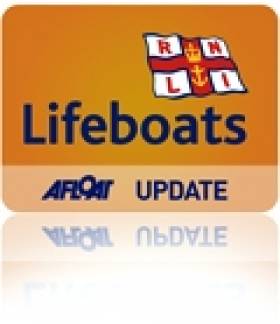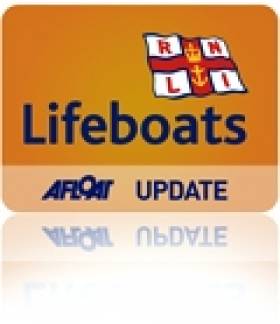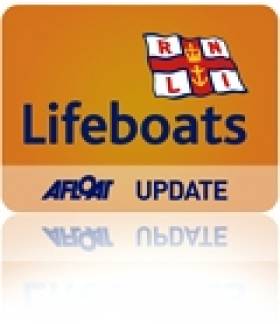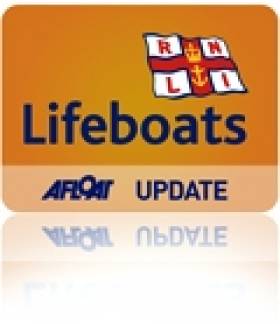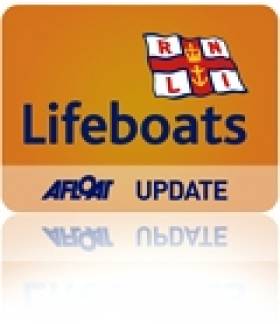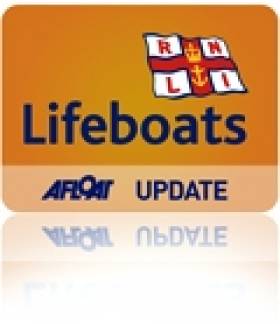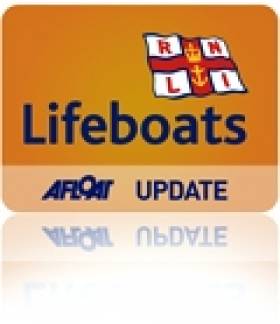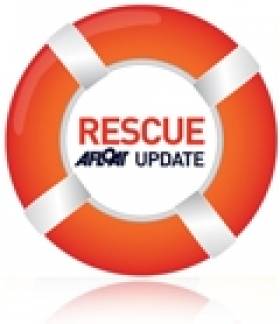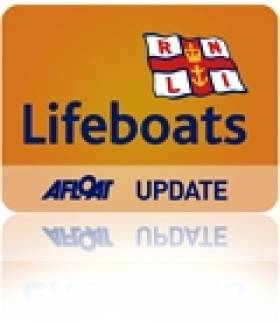Displaying items by tag: RNLI
#RNLI - Rosslare Harbour RNLI assisted two crew members on board a 40ft yacht which got into difficulty on Sunday night (10 May).
The alarm was raised by a member of the public at approximately 8pm who saw a boat making circles in the water and going side on to the weather, two miles inside of Tuskar Rock.
The volunteer crew launched their all-weather lifeboat at 8.05pm and were on scene four miles east, north east of Rosslare Harbour, within 20 minutes.
The yacht, with two crew members on board, had broken its main sail which then became tangled on deck. There were huge swells and breakers at the time.
On arrival, the lifeboat crew observed that the yacht’s crew had managed to disentangle the main sail. The lifeboat stood by until the yacht was free from danger and went to a safe anchorage.
Speaking following the callout, Rosslare Harbour RNLI lifeboat operations manager Dave Maloney said: "We would like to commend the member of the public who raised the alarm when they saw that the yacht was experiencing some problems.
"The sea was quite rough at the time but the crew of the yacht managed to bring the situation under control and we were happy to stand by until they were safe to proceed."
#RNLI - Kilkeel RNLI volunteer lifeboat crew Ernest McKee (helm), William Charleton, Suzanne McCullough and Gerry Smyth responded to a call at 8pm last night (Sunday 10 May) to go to the aid of the 25ft yacht Sundancer in difficulty south of the Hellyhunter Buoy, off Carlingford Lough.
The Sundancer, which had left Howth with a crew of three, had suffered a ripped headsail along with reported engine failure and an exhausted crew. There was a Force 6 northerly wind with a moderate sea and moderate visibility.
On coming alongside, Kilkeel RNLI crewmember Charleton managed to get onboard the yacht and assessed the state of health of the crew, one of whom was suffering from violent seasickness. He gave appropriate assistance to the casualty, making him as comfortable as possible using the ripped sail to keep the wind off.
Meanwhile, McCullough maintained contact with the yacht's crew to reassure them they were safe. When the sails were lowered, a towline was established and the vessel was towed to Carlingford Marina.
Following the callout, Smyth stated that "the rescue was carried out under difficult and trying conditions and helm Ernest McKee did a great job manoeuvring the lifeboat into position to allow William to get onboard the yacht.
"It was a textbook location and recovery operation; we train regularly for such tasks and everything went smoothly."
#RNLI - The volunteer crew from Enniskillen RNLI lifeboat station launched their inshore lifeboat from Carrybridge at 9pm last night (Wednesday 6 May) to go to the assistance of a 32-foot sports cruiser.
The powerboat, with four adults on board, had run aground in Trial Bay about a mile from the Crom Estate public jetty.
The boat could not be refloated and the four people on board were transferred to the lifeboat with their personal belongings and brought back to Crom Estate.
Galway Lifeboat Rescues Woman Swept Out To Sea
#RNLI - A woman was recovering in hospital in Galway last night (Wednesday 6 May) after being rescued by Galway RNLI lifeboat.
The alarm was raised by members of the public who spotted the woman in the River Corrib being swept out to sea.
They alerted the emergency services and a 'blanket' callout was made to the lifeboat, Garda, Irish Coast Guard, Galway Fire Brigade and the ambulance service at around 11.41pm.
Galway RNLI launched within minutes with helm Shane Folan and crew Dan King, Emma Hennessy and David Badger, and the woman was quickly located near waters at the Galway Enterprise Park at Galway Docks.
She was taken on board the lifeboat and brought ashore where she was transferred to a waiting ambulance and taken to University Hosptial Galway.
Galway RNLI shore crewmember John Byrne said: "The new emergency service plan for river rescues worked very well with all rescue services on the scene very quickly."
The rescue came a day after Clifden RNLI aided two lobster fishermen yesterday after their boat got into difficulty on the Connemara coastline.
At approximately 10.30am on Tuesday 5 May, Clifden RNLI's volunteer lifeboat crew was requested to launch by the Irish Coast Guard and go to the aid of two lobster fishermen in difficulty off the Aughrus peninsula.
Having experienced engine failure, the boat was drifting dangerously close to the rocks when its crew raised the alarm.
The Atlantic 85 inshore lifeboat Benjamin Downing Fairbridge was launched and was on the scene within 10 minutes of leaving shore.
Lifeboat helm Bernard Whelan and volunteer crew members Kenneth Flaherty, Joe Acton and Owen Hayes then towed the two fishermen in their boat back to Rossadillisk pier in Cleggan.
Speaking following the callout, Clifden RNLI lifeboat press officer Catherine Pryce said: "The crew responded rapidly and were delighted to be able to assist the fishermen."
#rnli – Last Saturday, over sixty young sailors from the Irish National Sailing School (INSS) headed out on quite a miserable Saturday to participate in the annual Irish National Sailing School's Sail-A-Thon. Now in its sixth year of existence, the idea of the sail-a-thon is to give younger sailors the opportunity to raise vital funds for a selected charity that is relevant to them. In previous years, these sailors have raised fund for Our Lady's Children Hospital in Crumlin but this year and last year, they have chosen to raise funds for the RNLI in conjunction with their Mayday campaign.
The young sailors spent the previous month collecting sponsorship monies for them to partake in our non-stop Sail-A-Thon which saw young sailors from as young as 6 battle conditions in which most DBSC racing was cancelled for up to 6 hours non-stop sailing. With winds in excess of 32 kts and driving rain, our young sailors to the seas in our fleet of Squib dayboats with the slightly older sailors utilising our diverse fleet of Laser Picos, Hartley training boats and other double handed dinghies.
Sailors fulfilled their sponsorship duties and returned ashore for a presentation with local Dun Laoghaire RNLI crew-members, Jenny and Johnny of the RNLI coming over to receive the funds raised and also to educate our younger sailors about the importance of the RNLI and where their funds would be used.
At the final count, INSS announced the sailors raised €1,936 euros.
Seven Kayakers Rescued After Bristol Channel Ordeal
#Rescue - Just days after a kayaker was rescued from the Bristol Channel comes footage of another rescue on the opposite side of that same body of water – this time of seven people kayaking off the Exmoor coast.
According to the Western Morning News, Minehead RNLI's Atlantic lifeboat launched on Sunday (3 May) to the kayakers who got into difficulty off the Foreland Point lighthouse but were able to reach the safety of the shore.
One of the kayakers had suffered an injured ankle, and all were transferred by lifeboats from Minehead and Ilfracombe to nearby Lynnmouth Harbour for treatment.
#RNLI - An eight-foot-tall yellow welly at the top of Grafton Street in Dublin was unveiled yesterday (Friday 1 May) to mark the launch of the RNLI's Mayday fundraiser.
The larger-than-life Wellington boot – which represents the yellow wellies worn by the charity’s volunteer lifeboat crew members – was one of a number that touched down at 9am in Dublin, London, Cardiff and Edinburgh to mark the start of the RNLI’s flagship fundraising campaign.
The charity is now issuing its own call for help and is asking people to support its Mayday fundraising campaign across the May bank holiday weekend.
Dedicated RNLI fundraisers will be out in force and a host of welly-themed events will be happening across Ireland and the UK till Monday 4 May.
Fundraisers and volunteer lifeboat crew members will accompany each giant yellow welly to collect donations and talk to members of the public about the RNLI’s lifesaving work.
The RNLI operates 45 lifeboat stations in Ireland and relies on 1,500 volunteer lifeboat crew to be on call to respond to those in trouble at sea or on the water.
Last year RNLI lifeboat crews launched 1,089 times in Ireland, rescuing 1,414 people and saving 44 lives. They are on-call 24/7, every day of the year, ready to respond emergencies.
Speaking at the launch yesterday morning, Howth RNLI crewmember and mechanic Ian Sheridan said: "We have been very busy with lifeboat callouts in Howth this year already. I would call on the public to support the RNLI this Mayday to ensure Irish lifeboats continue to save lives at sea.
"The Mayday campaign is vital for our charity to raise funds and awareness for the work we do."
Also present at the launch was Michelle Noone from the RNLI, who added: "We picked the lifeboat crew’s yellow welly as a symbol for the Mayday campaign and already this morning people have been stopping to photograph our eight foot welly and taking selfies with it.
"As well as being lots of fun we hope it will also make people stop and consider the work our volunteer lifeboat crews do and donate to our Mayday campaign this weekend."
To donate, visit RNLI.org/Mayday or text RNLIMAYDAY to 50300 to donate €4. Funds raised through the Mayday campaign will help fund the RNLI’s lifesaving work in Ireland.
Portaferry Lifeboat Joins Multi-Agency Search For Missing Woman
#RNLI - Portaferry RNLI's volunteer lifeboat crew were called out yesterday (Wednesday 29 April) to help in the search for a woman reported missing to police.
The RNLI lifeboat, an Inshore Atlantic 85, was launched at 5.05pm and the volunteer crew were on scene, just off Strangford village on the shores of Strangford Lough in Co Down, two minutes later to commence their search of the waters along the shoreline towards the northern end of the lough.
Weather conditions at the time had rain but with good visibility and a Force 4 westerly wind.
The multi-agency search included members of the PSNI, coastguard teams from both Portaferry and Bangor, and Rescue 116, the Irish Coast Guard helicopter dispatched from Dublin.
The volunteer RNLI crew searched Strangford Lough’s western coastline as far north as Salt Island before crossing to the eastern side and searching towards the southern end, through Ballyhenry Bay towards Portaferry and the stretch of water running between Portaferry and Strangford village known as The Narrows.
It was as the volunteer RNLI crew reached Portaferry that they received word to stand down as news came through that the missing woman had been found.
Speaking on behalf of Portaferry RNLI, lifeboat operations manager Brian Bailie said: "It is at times like this that all of the hard work and training our volunteers put in comes to fruition.
"Training with the other emergency and rescue services is essential for all concerned, as today certainly proves."
Six Junior Sailors Rescued In Dun Laoghaire Drama
#Rescue - Independent.ie reports on the dramatic rescue of six young sailing trainees after their dinghy overturned in a gust in Dun Laoghaire harbour yesterday afternoon (Sunday 26 April).
One of Dun Laoghaire RNLI's lifeboats spotted the children in trouble while returning to port from an exercise and helped the six out of the water.
#lifeboat – The RNLI is appealing for Irish yacht sailors who have not yet taken part in the charity's new research project, which is exploring attitudes towards risk and safety, and the various ways in which yacht sailors participate in their sport, to complete the survey before it is finished this Thursday (30 April).
There has been a strong initial take up but the charity is hoping for more respondents in the final days. Every response given will help the RNLI understand why people get involved in sailing and how they behave when they are on the water so we can provide the most relevant and useful safety information to them
The research, which is supported by the Irish Sailing Association (ISA) will look at what motivates sailors, how often they go to sea, their experience and training, awareness of potential hazards and use of safety procedures and equipment. The findings will be used to help develop tailored and relevant safety messages for the yacht sailing community.
An online questionnaire for yacht sailors in Ireland was launched at the end of March and is running for five weeks until 30 April. All of those who participate in yacht sailing who are based in Ireland – no matter how often or what level of experience – are encouraged to take part. The RNLI is asking people to log on to www.rnliyachtingIreland.substance.coop and complete the survey, which will take about 15 minutes.
The survey will also be supplemented by interviews with individual yacht sailors and yachting organisations as well as focus groups held in selected locations. The project will be undertaken by Substance research, a social research company who have produced research for the RNLI on a number of occasions, on behalf of the RNLI.
Pip Hare, RNLI Coastal Safety Manager, explains the reasoning behind the research project: 'The RNLI exists to save lives at sea – a large part of that role is trying to prevent incidents from happening in the first place by providing important safety information. We're always pleased to see people enjoying their leisure time at the coast and we want to help ensure they can take part in their chosen activity safely RNLI incident data shows lifeboat crews in Ireland have rescued almost 623 yacht sailors in the last five years.'
'We're working with the Irish Sailing Association to join expertise in coastal safety with experience of the sport. Once we have the results of the research, we will work together to develop the most suitable safety programmes and advice.'
All who participate in the survey are offered the option of free entry into a prize draw to win a McMurdo Fast Find personal locator beacon. A winner will be chosen at random on 31 May. Full terms and conditions for the prize draw, as well as further information about the study, can also be found through the above link.


























